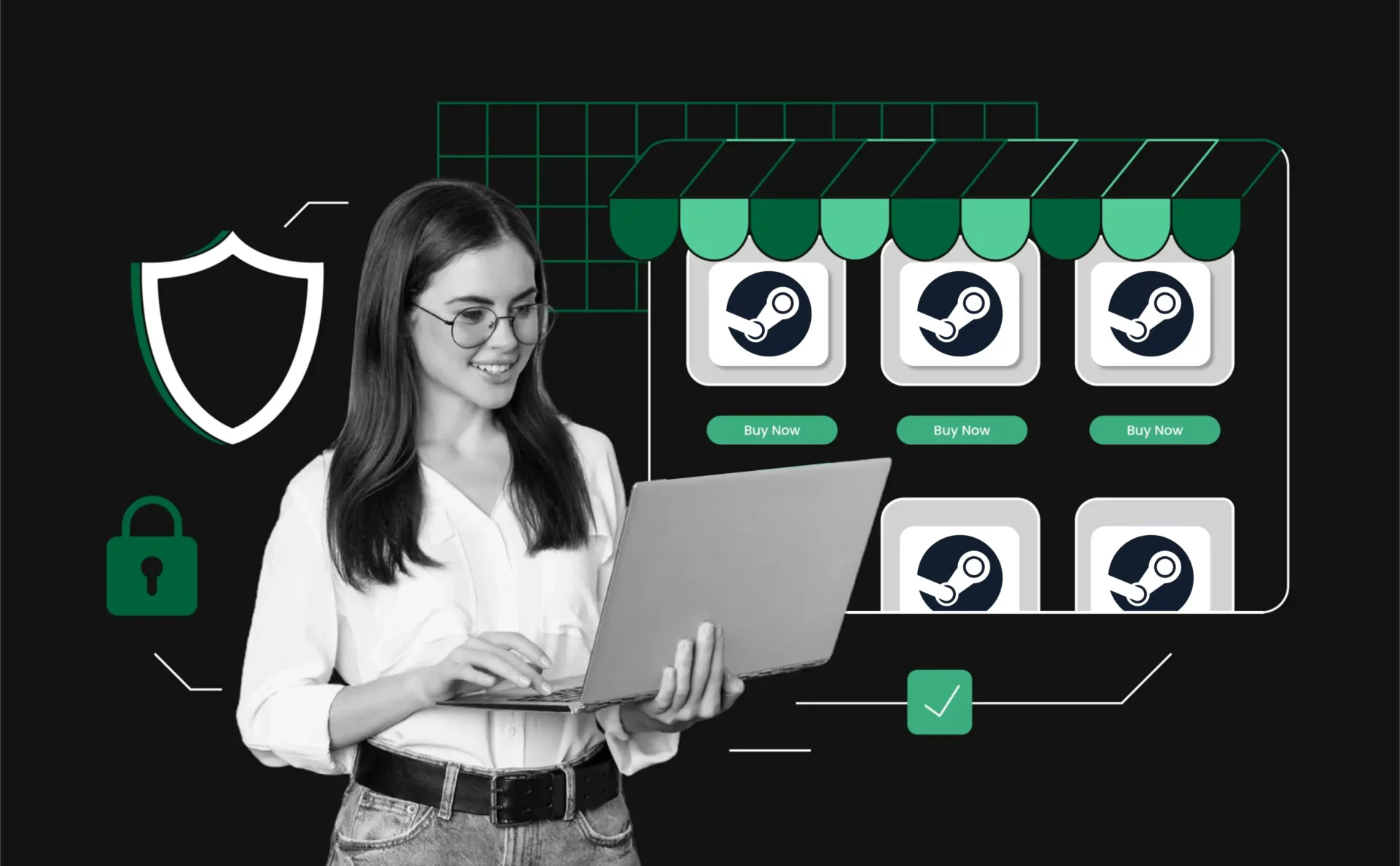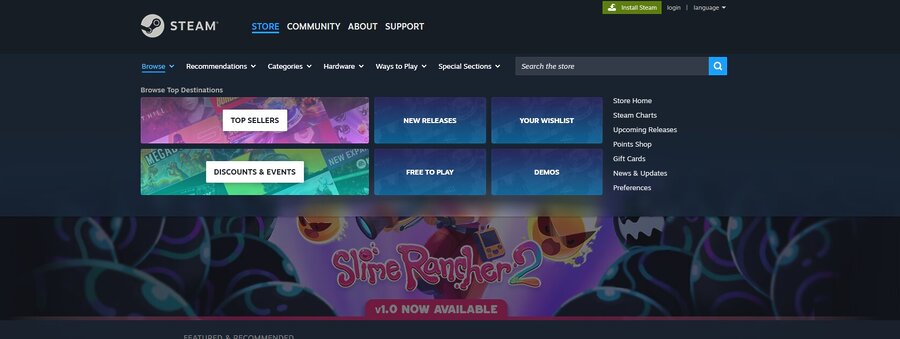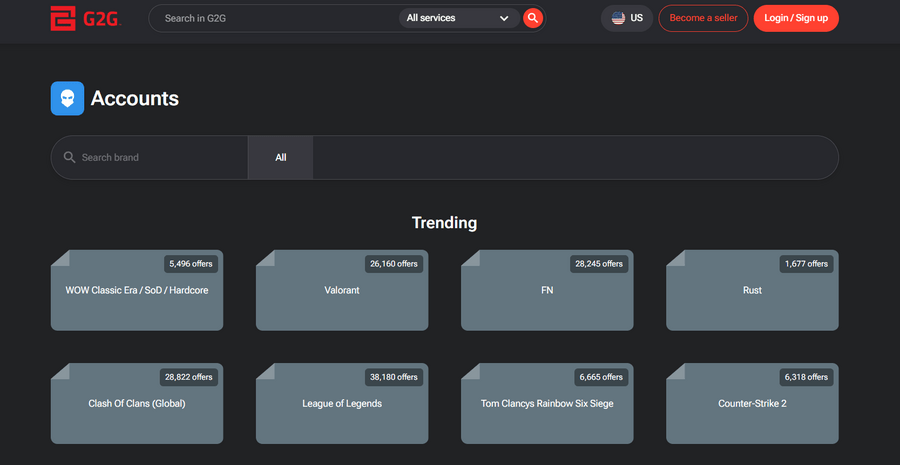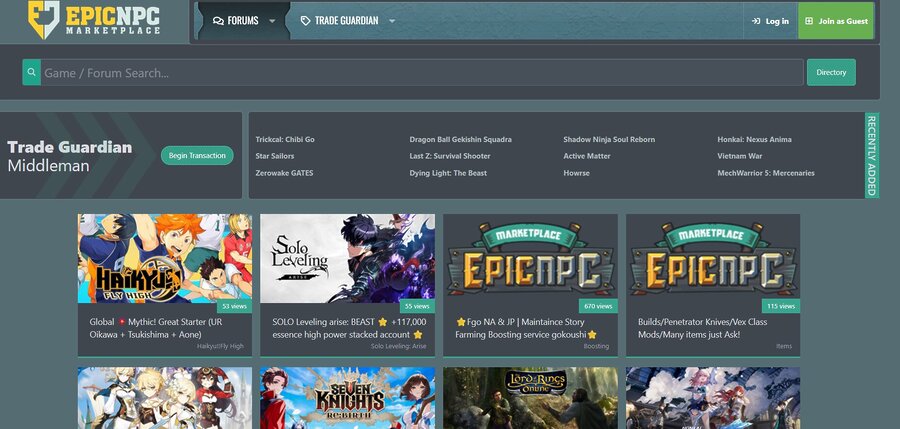
Sell Steam Account: How to Earn Money from Steam in 2025
Steam has become the world’s leading platform for PC gaming, with players investing heavily in games, skins, and achievements. Over time, these accounts can grow into valuable digital assets. Many players look to sell Steam account profiles as a way to recover costs or profit from their collections.
With the gaming market expanding and demand for established accounts rising, the Steam account resale market is more active than ever. In this guide, we’ll cover why people sell Steam accounts, where to list them, and what to know before getting started.
Why sell Steam accounts

Selling Steam accounts may seem unconventional, but there are several solid reasons why someone might consider doing it — especially in the light of how the gaming market is evolving.
1. Monetize underused assets
Many players accumulate extensive game libraries, skins, DLCs, or in-game achievements but later stop playing. A Steam account with desirable games or items can be turned into cash rather than sitting idle.
2. Recoup сosts
Building a valuable Steam library often involves significant investments in games, expansions, and DLCs. Selling the account allows you to recoup at least part of that cost (sometimes more, depending on demand).
3. High вemand for “Premium” accounts
Accounts with rare items, skins, high ranks, or long history tend to attract serious buyers. As newer players want shortcuts or want to access content quickly, demand persists for accounts with well-established assets.
4. A growing secondary market
The overall gaming industry is expanding rapidly, and that growth trickles down to secondary markets.
The global gaming market was estimated at about USD 298 billion in 2024 and is projected to grow at a CAGR of 8.7% through 2030.
- The Steam platform-games segment is projected to grow with a CAGR of around 8.9% from 2025 onward.[1]
- The second-hand game platform market is forecast to expand at a CAGR of roughly 12.7% from 2024 to 2032. [2]
- Beyond new sales, the second-hand gaming / used game / resale segment is also showing robust expansion: the second-hand game platform market is forecast to grow at a CAGR of ~12.7% from 2024 to 2032. [3]
These trends suggest that demand for digital gaming assets — including accounts — will continue to grow as gaming becomes even more mainstream.
Want to expand your reach on social platforms? See our step-by-step guide on how to buy a TikTok account safely and what to watch out for.
5. Accessibility & Global reach
Steam accounts don’t require shipping, so sellers can reach buyers worldwide. Regional restrictions often drive this demand.
In Russia, it’s currently impossible to buy many new titles on local Steam accounts. In Turkey and Argentina, cheaper regional pricing attracts international buyers. And in parts of the Middle East, some games are banned, pushing players to seek accounts from other regions.
These factors make global demand for Steam accounts stronger than ever.
How to start earning by selling Steam accounts
1. Choose which accounts to sell
Decide which accounts have market value. Typical categories:
- Single-game accounts with high progress or DLCs.
- Accounts with rare or valuable in-game items/skins.
- Established accounts with long play history, high ranks, or verified payment history.
Write down the key selling points for each account (games, DLC, skins, levels, achievements, playtime, region).
2. Verify ownership and compliance
Make sure you legitimately own everything on the account (purchase receipts, linked email, two-factor devices). Check whether any games or items are region-locked or bound to third-party services. Document proof of ownership — buyers will want assurance.
3. Choose an antidetect browser
If you need to run and manage multiple accounts without being flagged, use an anti-detect browser. Multiple accounts created from the same device are at higher risk of being banned, especially when accounts are transferred to other users.
If you’re worried about online tracking and account security, read our primer on browser fingerprinting to learn what it is and how it affects account management.
One of the most reliable options in this market is Multilogin — an antidetect browser designed for managing multiple accounts, widely used by people who monetize online. Don’t miss our special offer with the promo code.
4. Create unique browser profiles and Steam accounts
Each Steam account should be created with a unique browser profile to avoid linking accounts.
- Use your Multillogin antidetect browser to create separate browser profiles using built-in residential proxies
- Register each Steam account with unique email addresses and personal details
- Keep detailed records of account credentials and associated emails.
- Reusing personal information can lead to account linking and bans
- Avoid suspicious or automated behavior during account creation.
5. Fill accounts with assets
Increase the value of your accounts by adding games, in-game items, or other assets.
- Purchase popular or discounted games to add to accounts.
- Acquire in-game items, skins, or currency that are in demand.
- Complete basic achievements or levels to make accounts more appealing.
- Focus on games and items with high resale value.
- Use sales and bundles to minimize your investment.
6. Secure the account before listing
- Remove any personal information you don’t want to transfer (saved payment methods, personal email addresses — transfer ownership to an email you control).
- Enable or note current security features (Steam Guard status, linked phone/email) and be ready to provide a handover plan.
- Record the exact contents of the account (screenshots or exported lists of games, items, wallet balance).
7. Prepare a clear listing
Create honest, detailed listings that include:
- A short, clear title (e.g., “Steam account — 150 games incl. AAA titles + rare CS:GO skins”).
- Full inventory summary (notable games, DLC, skins/items, wallet balance).
- Screenshots proving key assets and account status.
- Account region and any restrictions (important for international buyers).
- Terms of sale: price, payment methods accepted, refund or dispute policy, and how you will transfer ownership.
8. Choose reputable marketplaces or channels
Prefer platforms that provide escrow or buyer/seller protections (and check their policies about account sales). If using peer-to-peer channels, insist on escrow and documented transfer steps. Avoid informal transactions with unknown buyers when possible.
9. Price competitively and account for fees
Research similar listings to set a realistic price. Factor in:
- Platform fees and payment processing fees.
- Risk premium (accounts with disputed or restricted items are harder to sell).
- Time to find a buyer.
10. Use secure payment and escrow
Whenever possible, use an escrow service offered by a reputable marketplace to hold funds until both parties confirm the transfer is complete. If you must accept direct payment, prefer traceable, secure options (and be very cautious of chargebacks or scams).
11. Execute a transparent handover
Provide step-by-step instructions for the buyer and keep a record of the handover:
- Change account email and recovery options in the buyer’s presence (or coordinate via escrow).
- Transfer credentials securely (never post them publicly).
- Confirm the buyer can log in and access key games/items before escrow release.
12. After-sale steps
- Remove the account from your device(s) and revoke saved passwords.
- Keep copies of communications and transaction receipts for dispute resolution or tax purposes.
- If applicable, report the sale on your taxes according to local regulations.
13. Manage risk and alternatives
Understand the risks — Steam may take action against accounts sold in violation of its terms. Consider safer alternatives:
- Sell tradable in-game items through official markets (where allowed).
- Sell unused giftable copies or game keys you legitimately own.
- Offer services (account boosting, coaching) that don’t require transferring accounts.
Where to sell Steam accounts
If you decide to sell a Steam account, there are several platforms and marketplaces that can facilitate the process. Each option has unique advantages and drawbacks, so consider them carefully before choosing.
1. PlayerAuctions

Pros:
- Established marketplace with strong buyer and seller protections.
- Escrow service ensures secure transactions.
- A large user base increases chances of finding a buyer quickly.
Cons:
- Platform fees may reduce your profit margin.
- High competition from other sellers can drive prices down.
2. G2G

Pros:
- Secure environment with payment protection and dispute resolution.
- Large, international marketplace with many potential buyers.
- Offers multiple payment options.
Cons:
- Service fees apply, which can cut into earnings.
- Some buyers report longer transaction times compared to other platforms.
3. EpicNPC

Pros:
- Free to post listings, lowering entry costs.
- A strong community reputation system encourages trust.
- Niche audience focused on gaming accounts.
Cons:
- Less structured protections compared to escrow-based platforms.
- Reliant on personal reputation, which can be difficult for new sellers.
4. Reddit Communities (e.g., r/GameSale, r/SteamGameSwap)
Pros:
- No platform fees, so you keep the full payment.
- Direct communication with buyers.
- Large audience of gaming enthusiasts.
Cons:
- No formal protections or escrow services, making scams more likely.
- Transactions may violate subreddit rules or Steam’s terms of service.
- Buyer trust can be hard to establish without prior reputation.
5. Direct Peer-to-Peer Sales
Pros:
- No middleman fees — you keep all the profit.
- Familiarity with the buyer (friends or acquaintances) can simplify the process.
Cons:
- No safeguards if the buyer refuses to pay.
- Higher risk of disputes without a neutral mediator.
- Limited pool of buyers compared to marketplaces
Legal Considerations
Selling Steam accounts comes with significant legal and ethical risks that should not be overlooked:
Steam Subscriber Agreement
Valve explicitly prohibits the transfer or sale of accounts under the Steam Subscriber Agreement. Violating these terms can result in a permanent ban for both the buyer and the seller.
Security and Fraud Risks
Sharing or transferring login credentials exposes both parties to fraud, scams, and potential hacking attempts. Once an account changes hands, recovering it can be difficult or impossible.
High Scam Potential
Without trusted escrow or verification services, sellers risk non-payment, while buyers may receive compromised or reclaimed accounts.
Disclaimer
Selling Steam accounts is against Valve’s policies and may lead to account suspension or permanent bans. If you choose to proceed, understand that you do so entirely at your own risk.
Sources
[1] Grand View Research, Gaming Market Report
[2] Data Insights Market, Steam Platform Games Report
[3] openPR – Second-Hand Game Platform Market Report
Conclusion
Selling Steam accounts can be a profitable venture if approached carefully and with full awareness of the risks involved. Choosing the right marketplace, understanding legal restrictions, and employing tools like multilogin for efficient account management are key factors for success. Always prioritize security and be mindful that selling Steam accounts violates Steam’s terms of service, which can lead to account bans. Proceed with caution and informed judgment.